The wind-blown plains and mesas of New Mexico’s Melrose bombing and gunnery range are dotted with targets, from the hulls of tanks to ammunition carriers, from gun emplacements to mock SA-6 anti-aircraft batteries. Over the years, fighter pilots had taken aim at them and fired countless rounds.
In December, however, the Air Force’s New Mexico-based F-16 fighters roared out on their last mission from Cannon Air Force Base. The forces of Air Force Special Operations Command began moving in.
The change was ordered up by decision-makers in the 2005 Base Realignment and Closure process. Out at Cannon, AFSOC is building its new 27th Special Operations Wing, which will be the first of its kind outside of Hurlburt Field, Fla., and only the second special operations wing in the United States.
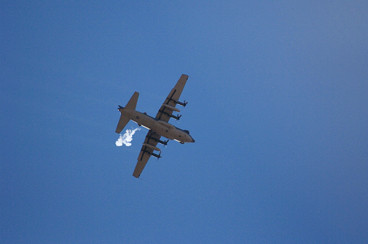 |
A plume of smoke rises from a direct hit on an ammunition carrier at one of the range’s two gunship targets. (USAF photos by Amn Elliott Sprehe) |
Over the next six years, Cannon will experience a massive makeover. It will see the addition of up to nine squadrons of special operations forces and aircraft, the introduction of the CV-22 Osprey and the MQ-9 Reaper to AFSOC operations, and an expansion of Air Force special tactics training into the desert upland of eastern New Mexico.
In those wide-open spaces, air commandos, gunships, and tilt-rotor aircraft will be able to train with a broad collection of Air Force assets and other SOF elements. Dedicated areas on the range are being set aside for the practice of assault landings and special tactics. The participants will include pararescue jumpers, combat controllers, and combat weathermen, all Air Force specialities.
Near the Melrose Training Range’s dirt landing strips, one finds a motley collection of target ammunition carriers. It is a tableau of outsize holes and disturbed earth—not from bombs, but from the impact of cannon rounds fired from an AC-130H Spectre gunship during training late last fall.
Col. Timothy J. Leahy, 27th SOW commander, said the gunship flight was a key step in proving the concept of a live fire range in the area.
Johnny Rogers, the civilian Melrose area range chief, points out that the eastern New Mexico high plains boast one big asset that the air commandos hold in high regard—clear flying weather for more than 300 days of the year. This will prove to be a boon in the training of battlefield airmen, especially for combat controllers—who will have primary access to vital training on the ranges.
No specific unit has yet been tagged for immediate transfer to Cannon. However, AFSOC officials said a squadron of special tactics airmen will be relocating to the base fairly soon. In the meantime, combat controllers, combat weathermen, PJs, and other types of battlefield airmen will visiting Cannon on temporary duty assignments. The TDYs will be for training and for determining the possibilities and limitations of the range space.
The range’s dirt strips will also become primary staging areas for AFSOC’s new PC-12 nonstandard aircraft (NSA). The NSAs are light airlifters designed for operation on rugged and austere airstrips, such as those found in Africa, the Middle East, and Central Asia. A squadron of the PC-12s, the 318th SOS, will activate this month.
Lt. Col. Toby Corey, director of operations for the 27th Special Operations Support Squadron, said Cannon personnel in December hosted several Navy SEALs from San Diego. They came out to the facility to evaluate possible ways that Navy personnel could train with the Air Force’s special operators. “We are in discussions … to see how we can get the most use out of this place,” he said.
For the airmen in charge of maintaining and equipping the new mission and aircraft, the transition is anything but simple.
“There’s a little bit of a cultural change, but not a remarkable change,” Leahy said of the transition. “Everyone still wears an Air Force patch. We’ve all grown up in the same culture. The difference is on the edges, how we execute the mission.”
Moving the low-density, high-demand special tactics airmen and airframes is no easy task. For example, AFSOC has decided to relocate the Vietnam-era AC-130H fleet—in its entirety—to Cannon beginning in late 2009. The shift will occur as the gunship fleet is in heavy rotation to and from Southwest Asia, and the newer AC-130Us will keep Hurlburt Field as their home station.
Appearances Can Be Deceiving
“All aircraft that we shift out here across the force will have to do so in a phased approach as we continue deploying them and fighting in combat,” Leahy said.
In early December, a visitor to Cannon found that much of the activity needed to beddown the air commandos and their gear was taking place behind the scenes. A lone MC-130W sat on the base’s ramp, surrounded by a few maintainers, while construction workers carried out relatively small projects near a patch of maintenance buildings.
However, appearances can be deceiving, said Leahy.
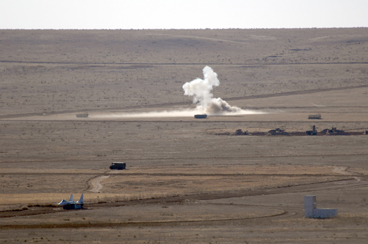 |
An AC-130H Spectre gunship fires cannon rounds onto the Melrose Training Range in New Mexico. (USAF photos by Amn Elliott Sprehe) |
“The great majority of the work that is occurring is not obvious to the casual observer who would drive onto Cannon Air Force Base today,” Leahy said. He noted that, beyond the flight line, subtle changes were occurring.
When the 2005 BRAC findings were released, Cannon was targeted for closure but was offered a stay of execution. If the Defense Department could find a suitable mission for the base, the BRAC commissioners declared, the Air Force could keep the base open and operating. AFSOC, which had long desired a base in the West to complement Hurlburt in the East, jumped at the chance to pluck off Cannon and the nearby Melrose range.
The facility and surrounding ranges will see an enormous amount of construction and re-engineering over the next few years as facilities are adapted to the SOF mission.
Sleek fighters with one or two crew members are being replaced with hulking C-130 airlifters, tilt-rotor CV-22 aircraft, and AC-130 gunships. The specialized weapons systems have larger aircrews and demand far more ramp and hangar space.
When the conversion to the AFSOC mission is complete, there will be about 5,600 AFSOC personnel permanently stationed at Cannon. Even in its heyday, shortly before the 2005 BRAC round, Cannon was home only to about 3,500 uniformed personnel.
As a result, careful space planning is required. Lt. Col. Stephen D. Wood, commander of the 27th Special Operations Civil Engineer Squadron, noted that some older base facilities will be temporarily converted to new uses while the construction of more permanent structures goes on.
“We aren’t going to knock down every F-16 hangar because [C-130s] don’t fit,” he said.
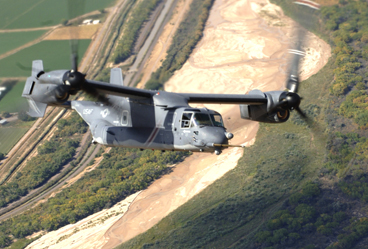 |
A CV-22 Osprey flies over New Mexico. (USAF photo by TSgt. Cecilio M. Ricardo Jr.) |
Wood’s engineers will try to find key spots in which airmen can carry out missions involving the incoming gunships and MC-130W Combat Spears until military construction funds kick in during 2011.
In the long term, Cannon’s landscape will shift significantly. The base’s only permanent hangar that can handle a C-130 needs a tail enclosure and some other improvements before it can be used for that purpose. The project is slated for completion by November, while two temporary C-130 hangars will be constructed on the present ramp this summer.
All the new C-130 traffic will require improvements to taxiways, Wood points out.
“An F-16 is known as a FOD sucker,” he quipped, referring to the risk that a powerful jet engine will “inhale” rocks and other items that cause foreign object damage. The incoming C-130, conversely, is a “FOD generator” for everyone else. “Those props on the outside of your taxiways will push stones up,” he explained, because a C-130’s two large outboard engines can overhang the edges of the runway.
As the 73rd SOS and its new MC-130W Combat Spears grow to full capacity in the coming year, the 3rd SOS—AFSOC’s Predator unit—will transition down from Creech AFB, Nev., beginning in the summer.
Construction is already under way to prepare for the 3rd SOS arrival. Corey pointed out space behind one of Cannon’s old maintenance buildings near the flight line where Predator ground control station pads are under construction.
Freeing Up Space
Simulation facilities are planned nearby for MC-130 crews, gunship crews, and the CV-22 Osprey. All 12 of the 73rd SOS Combat Spears are expected on the ramp by 2010.
With AC-130H gunships slated to begin arrival in FY 2009, space will become a problem very quickly, Corey conceded. Maintenance and operations facilities are among the most critical to the build-up, Corey added. “We’re not getting a lot of that [military construction] money until 2011, so it makes it difficult to beddown these units,” he said.
Beginning in FY 2013, a new ramp is planned on the base’s southeast side—giving MC-130s and gunships a permanent home. The ramp will also free up the north side for the beddown of CV-22s, Predators, and nonstandard aircraft—such as the command’s new PC-12 light airlifter.
Several AFSOC officials noted efforts are under way to accelerate the construction of the southeast ramp, and pointed out that if the current time frame holds steady the ramp space will get very constrained. With little modification, facilities which once housed F-16s will host CV-22s and even Predator aircraft in the near future.
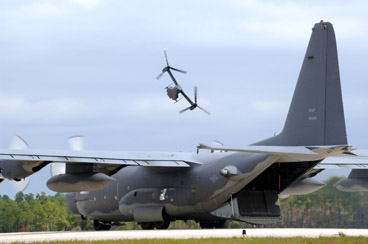 |
An Osprey swoops over the Hurlburt Field, Fla., flight line. In the foreground is an MC-130H Combat Talon. Both the CV-22 and the MC-130 will soon set up shop at Cannon as well. (USAF photo by SrA. Ali E. Flisek) |
“This is more than a transition,” said Maj. Roderick Webb, commander of the 27th Special Operations Aircraft Maintenance Squadron. “This is really a brand-new stand-up if you think about it from the maintenance standpoint.”
SMSgt. Steven Hettinger, lead production superintendent for the 73rd SOAMXS, can verify the complexity of shuffling around vital maintenance personnel. Inside one of Cannon’s old F-16 hangars, Hettinger said only his avionics airmen were transitioned in place from the F-16 operation to the new C-130 mission.
At least 30 additional maintainers are expected to arrive at Cannon by the end of March—valuable crew chiefs, hydraulics airmen, and engine mechanics to service the influx of MC-130 “Whiskeys.”
“This will get us above water. … We can keep the birds flying,” Hettinger added.
The move by AFSOC to expand operations to Cannon comes at a time of unprecedented buildup for the air commandos—all while called upon extensively in the Global War on Terror.
Col. J.D. Clem, AFSOC deputy director of plans, programs, requirements, and assessments, said the command hopes to effectively duplicate the combat capability based in northwest Florida. “The vision is that we will end up a near mirror image of what we have at Hurlburt. … It won’t be identical, but we will have a similar type unit at both bases.”
While AFSOC has been searching for a western base since at least the early 1990s, Hurlburt Field—and the surrounding ranges—has slowly filled up. At Eglin, if “everyone came home, we wouldn’t have room to park it all,” Clem noted. In 2005, Hurlburt was also hit with two successive hurricanes that put a bit more urgency into the planned force expansion.
Split the Assets
Having all of AFSOC’s assets in one place was a liability, Clem noted, and a weather event that seriously impacted Hurlburt could “devastate” AFSOC’s capabilities.
The military airspace on the Eglin Range and the areas around Fort Walton Beach are quickly becoming saturated with flights from nearby Eglin Air Force Base and NAS Pensacola.
“The big thing was the range,” said Corey of the Melrose range. “We can own this range and run the access. We’ll have top priority, which we don’t necessarily have out near Hurlburt and Eglin.”
Part of the appeal of the sparsely populated eastern plains of New Mexico is revealed with a look at a topographical map of the area surrounding the cities of Clovis, Portales, and the town of Melrose. It has not gone unnoticed that the altitude and some of the environmental conditions around Cannon and Melrose are similar to what special ops forces experience in Central Asia and the Middle East.
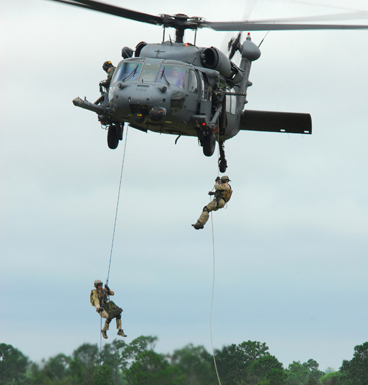 |
Pararescuemen rappel from an HH-60G helicopter at Moody AFB, Ga. PJs and other SOF personnel will have a range area at Cannon set aside for them. (USAF photo by TSgt. Parker Gyokeres) |
The Melrose range measures about 60,000 acres around the small town of Melrose, about 25 miles west of Cannon. About 8,800 acres are designated “impact acres”—space where actual strafing and bombing occur. In addition to a complete absence of urban encroachment, the space is well-equipped for advanced combat training. Dirt landing strips, bunkers, IR targets, and electronic jamming towers are spread out over the range’s impact areas.
“You’ll have air and ground pieces working in unison and that means a variety of folks will come out [here],” said Maj. Brian Thompson, 27th SOSS chief of current operations.
The range is currently equipped with 101 scoreable targets, as well as mobile electronic warfare training capabilities. It is “a phenomenal asset,” said Thompson. The range can host a wide variety of aircraft and units—from airdrop exercises involving MC-130s, to close air support training with combat controllers, to unmanned aerial vehicle missions.
The ability to simulate numerous threats at the push of a button is a fantastic SOF training tool, wing officials said. Lt. Col. Dan Wolf, the 27th SOSS commander and a former F-16 pilot who stayed on with the transition, said a dedicated SOF range will have huge implications for training and readiness.
Simulators that pepper the range can mimic every conceivable danger to aircraft—from anti-aircraft artillery to missile batteries—some of which can provide feedback in real time.
“We’ll have live fire operations that we haven’t had in the past, we’ll have [better] airdrops, … and we will have a ground presence to a degree that we have not seen in the past,” Wolf said.
While Cannon’s neighbors may no longer hear the frequent roar of F-16 afterburners, the combat capability the Air Force is building at Cannon will be no less lethal.